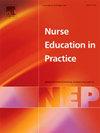间歇性导尿教育中移动学习与面对面培训的比较:一项随机对照试验。
IF 4
3区 医学
Q1 NURSING
引用次数: 0
摘要
目的:本研究旨在比较接受移动学习和面对面培训的护生在间歇导尿方面的知识和技能水平。背景:采用正确的技术进行间歇置管(IC)可以显著预防置管相关并发症。确保护士精通IC,可以防止并发症,并能够及时准确地执行手术。设计:平行组、非劣效性、随机对照试验。方法:采用分组随机法,将74名本文章由计算机程序翻译,如有差异,请以英文原文为准。
Comparison of mobile learning and face-to-face training in intermittent catheterization education: A randomized controlled trial
Aim
This study aimed to compare the knowledge and skill levels of nursing students who received either mobile learning or face-to-face training on intermittent catheterization.
Background
Performing Intermittent Catheterization (IC) with the correct technique can significantly prevent catheterization-related complications. Ensuring that nurses are proficient in IC prevents complications and enables timely and accurate execution of the procedure.
Design
A parallel-group, non-inferiority, randomized, controlled trial.
Method
A total of 74 fourth-year nursing students in Türkiye were randomly assigned to either the face-to-face training (n = 37) or mobile learning group (n = 37) using block randomization. The study provided intermittent catheterization training via mobile application or traditional face-to-face instruction between April 10 and April 17, 2025. Data were collected using the IC Knowledge test and a skills checklist for both male and female catheterization procedures.
Results
No significant difference was determined in the IC knowledge score between mobile learning (14.21 SD 1.58) and face-to-face training (13.56 SD 1.78) groups. There was also no significant difference in the skill performance score between the mobile learning (18.51 SD 1.57/19.13 SD 1.15) and face-to-face training (18.62 SD 1.31/18.56 SD 1.70) groups in respect of female/male catheterization procedures. The results showed that mobile learning on IC was non-inferior (non-inferiority margin: −1.02, 95 % CI: −0.13–1.43).
Conclusion
Mobile learning was found to be as effective as face-to-face training in enhancing both knowledge and practical skills in intermittent catheterization. Mobile applications can be considered as a supplement to face-to-face training in nursing education or as an alternative when face-to-face training is not possible.
求助全文
通过发布文献求助,成功后即可免费获取论文全文。
去求助
来源期刊

Nurse Education in Practice
NURSING-
CiteScore
5.40
自引率
9.40%
发文量
180
审稿时长
51 days
期刊介绍:
Nurse Education in Practice enables lecturers and practitioners to both share and disseminate evidence that demonstrates the actual practice of education as it is experienced in the realities of their respective work environments. It is supportive of new authors and will be at the forefront in publishing individual and collaborative papers that demonstrate the link between education and practice.
 求助内容:
求助内容: 应助结果提醒方式:
应助结果提醒方式:


